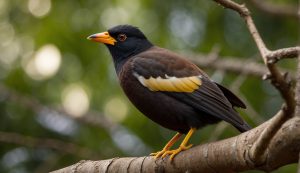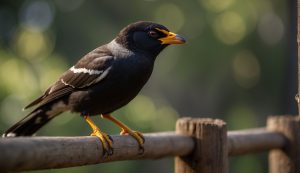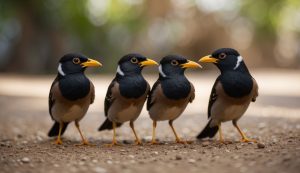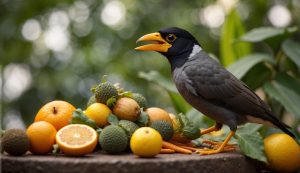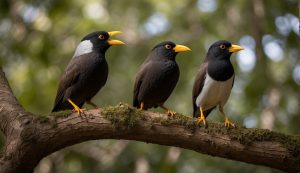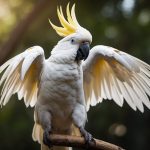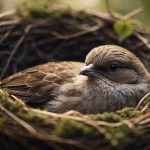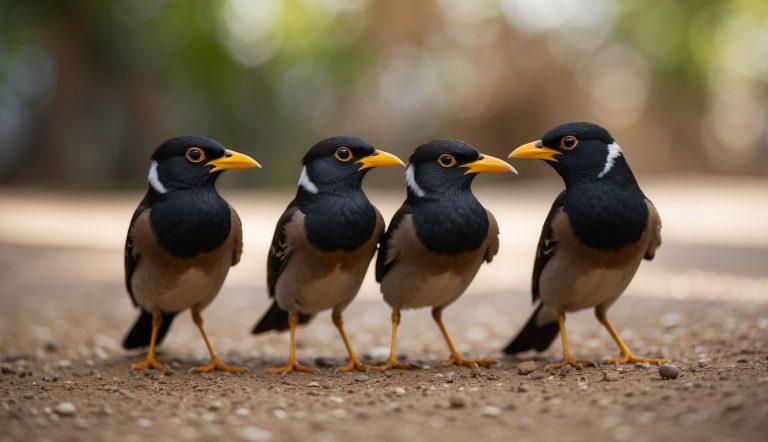How to Care for Baby Mynah Birds: Essential Tips for Beginners

Rearing baby mynah birds is a fulfilling yet demanding task that requires special attention and care to ensure the birds grow into healthy, well-adjusted adults. As an intelligent and sociable species, mynah birds often bond closely with their caretakers.
To foster this connection and support their development, it’s imperative to establish a nurturing environment from the outset.
This includes a quiet, stable habitat to mirror the secluded nests they might find in the wild, as well as specific dietary and health management routines to cater to their unique needs.
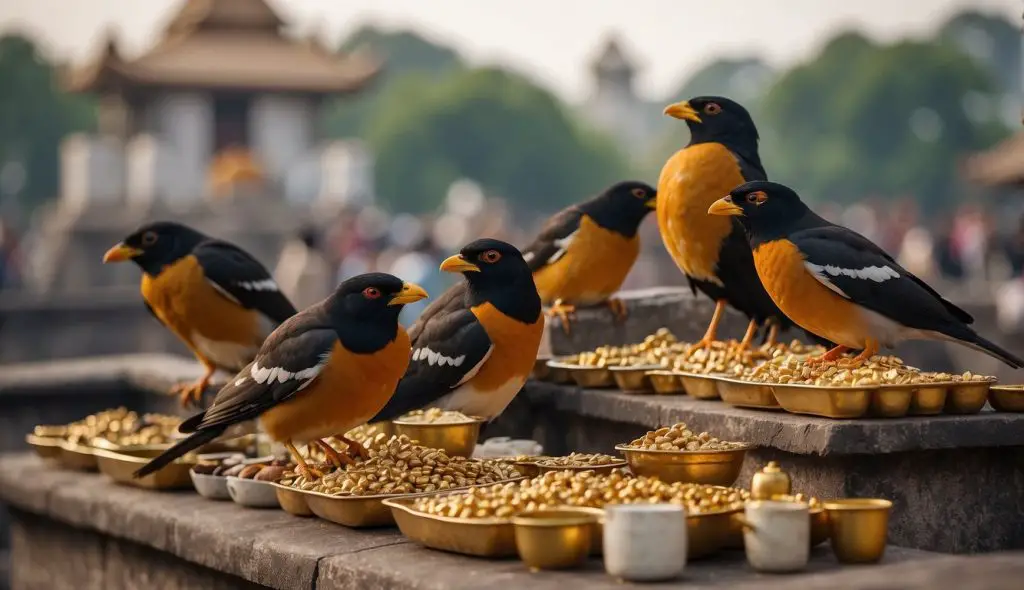
The first thing to consider when caring for baby mynahs is their diet, which differs significantly from that of adult birds.
They need a high-protein formula suitable for their rapid growth phase, coupled with careful feeding schedules that mimic the frequency with which parent birds would feed their chicks.
Observing your baby mynahs during feeding can also provide insights into their health and well-being, helping identify any issues early on.
Beyond that, young mynahs need regular interaction and training to develop their vocal abilities, including their remarkable skill of mimicking human speech, which necessitates a tranquil and consistent training environment.
Key Points
- Providing a stable and nurturing environment is central to raising baby mynahs.
- A specialized high-protein diet and regular feeding schedule are crucial for their development.
- Interaction, training, and monitoring health are essential for the well-being of baby mynah birds.
Table of Contents
Getting Started with Your Baby Mynah
Caring for my baby mynah begins with selecting a habitat where they’ll thrive. I’ll guide you through choosing a spacious cage and arranging a comfortable setting inside.
Choosing the Right Cage
When it comes to housing for my mynah, size definitely matters. I aim for a large cage to ensure enough space for flying and exercise. I’ve found that a cage with dimensions of at least 24 inches wide, 18 inches deep, and 34 inches tall works well.
Here’s a quick checklist I use when selecting a cage:
- Spacious enough: Room for flight and activities.
- Bar spacing: Ideally between 1/2 inch and 3/4 inch to prevent escapes or injuries.
- Sturdy material: Stainless steel or coated metal resists chewing and is easy to clean.
Creating a Comfortable Habitat
Once I’ve chosen the right cage, I focus on the inside to make it a cozy home. I ensure to include:
- Perches: Different diameters to exercise their feet. I place them at various heights to simulate a natural environment.
- Nest box: It provides security for the mynah and serves as a sleeping spot.
- Toys: Essential for mental stimulation and physical activity. I avoid toys with small parts that could be ingested.
- Baths: Mynahs love to bathe, and I can either provide a small water dish or a bird bath for this purpose.
Creating an enriching environment is about balancing practicality with comfort, making sure water is available at all times, and keeping the habitat stimulating.
Here’s a simple table I follow for the habitat essentials:
| Habitat Necessities | Description |
|---|---|
| Nest Box | A secure area for my mynah to retreat. |
| Perches | Of varying diameters for healthy feet. |
| Toys | To keep my mynah engaged and active. |
| Bath | For hygiene and enjoyment. |
| Water | Fresh water for drinking. |
Feeding Your Baby Mynah
To ensure the health and happiness of your baby Mynah, proper nutrition is crucial. Baby Mynahs have specific dietary needs that differ from adult birds, requiring careful selection and preparation of their food.
Understanding Mynah Diets
Baby Mynahs thrive on a diet that’s rich in variety and nutrients. I focus on three main components: fruits, insects, and formulated pellets.
Fruits offer essential vitamins, while insects provide protein necessary for growth. It’s also important to include specially formulated Mynah bird pellets which are tailored to their unique needs and help prevent iron storage disease, a common health issue for Mynahs due to their sensitivity to excess dietary iron.
The composition of a baby Mynah’s diet can look something like this:
- Fruits: 40%
- Insects: 40%
- Pellets: 20%
Preparing and Serving Meals
For fruits, I stick to a variety of safe options such as apples, pears, and berries, ensuring they are finely chopped or mashed for easier consumption. Bananas are a favorite but are high in iron, so I moderate their intake. I also conscientiously avoid avocados, which are toxic to Mynahs.
When it comes to insects, I focus on providing gut-loaded (fed with nutrient-rich food before being offered to the bird) or dusted (coated with a vitamin and mineral supplement) insects like mealworms, crickets, or waxworms which I serve live or dried, depending on what’s available and their own preference.
Pellets are a convenient way to round out their diet, making sure they are low in iron and specifically formulated for Mynahs or softbill birds. I carefully measure the portion to prevent overfeeding, soaking them in water to soften them up for my young bird.
As for feeding schedules, I feed my baby Mynah multiple times a day, noting that their feeding frequency decreases as they grow. It’s a balance of observing their appetite and ensuring they’re satisfied but not overfed, to help maintain optimal health.
Health and Wellness
In caring for baby mynah birds, I focus on maintaining their health through proper nutrition and staying vigilant for signs of illness. It’s critical to arm yourself with the right knowledge to keep these birds thriving.
Preventing Nutritional Disorders
Mynahs require a specialized diet as they are prone to nutritional disorders like hemochromatosis, a condition caused by excess iron storage. To prevent this, I provide a low-iron diet, which is commercially available and formulated specifically for mynahs. Moreover, I make sure they have access to clean water at all times.
Here’s how I balance their diet:
- Fruits and Vegetables: Offer a diverse range to ensure they get all the necessary vitamins and minerals.
- Protein: Include high-quality protein sources such as insects or commercial pelleted diets.
Recognizing and Addressing Illness
Even when I do everything right, mynah birds can still fall ill. I stay alert for signs of sickness, such as changes in their vocalization, feathers, or droppings. Here’s what I look for and how I respond:
- Changes in Behavior: Lethargy or reduced vocal activity may indicate illness.
- Droppings: Sudden changes in color or consistency can be a red flag.
- Feathers: Dull or fluffed-up feathers can signal that the bird isn’t feeling well.
At the first sign of trouble, I consult with a vet who specializes in avian medicine. A healthy bird is a lively and active bird, so any deviation from their normal behavior warrants a visit to a veterinarian.
Training and Socializing

When it comes to nurturing baby mynah birds, it’s crucial for me to engage in regular training and socializing activities to aid their development. This not only helps them learn to talk but also ensures they form a strong bond with me, enhancing our interaction.
Teaching Your Mynah to Talk
- Tools You’ll Need: A quiet room, patience, and a consistent schedule.
- Key Steps:
- Begin by speaking to my mynah in a clear and repetitive manner.
- Practice common words and phrases I want my bird to learn.
- Use treats and positive reinforcement when they mimic sounds correctly.
It’s important for me not to rush the process as these birds require time to learn and understand. Concentrating on a few words or sounds at a time can be more effective than overloading them with too much information.
Bonding and Interaction Tips
- Bonding Basics: Spend time daily with my bird to establish trust.
- Socializing Strategies:
- Introduce new people and environments gradually to avoid overwhelming my mynah.
- Encourage interaction by allowing my bird to observe my daily activities.
Socialization should be a gradual process to ensure my mynah becomes comfortable with various situations and people. Considering their need for social interaction, I make it a point to be an active participant in their daily routine.
Daily Care and Maintenance
I know how essential a clean environment and regular care are for the well-being of baby mynah birds. Here’s how I manage to keep them in tip-top shape through daily attention to their habitat and needs.
Cleaning and Upkeep of the Cage
I make it a point to clean the baby mynah’s cage every day. Here’s my routine:
- Replace the liner or substrate at the bottom of the cage to keep it fresh and absorb waste.
- Wipe down all surfaces with a bird-safe disinfectant. This includes perches, toys, and the interior of the cage.
- Ensure that there are no sharp edges or loose wires that could harm the bird.
- Offer a small bath dish with fresh water. It’s vital for the bird’s hygiene and enjoyment. Alternatively, I sometimes use a light misting as a form of bath; they seem to love it!
Routine Care for a Happy Mynah
For their daily routine care, I focus on a few key aspects:
- Diet: I provide a balanced diet tailored for mynahs, which includes commercial softbill food. This keeps my baby mynah healthy.
- Interaction: Daily interactions are a must for their mental health, so I talk and play with them regularly.
- Toys: I rotate their toys to keep things exciting and stimulating. I also make sure they are safe and appropriate for mynah birds.
- Safety: It’s crucial to keep their living space secure from any hazards. Also, monitor any interactions with other pets or potential stressors to protect my young friends.
Frequently Asked Questions
In this section, I’ll be addressing some common inquiries regarding the care of baby mynah birds.
These questions will help you understand their dietary needs, determine their age, care for a foundling, abide by legal guidelines, select suitable fruits, and know about their lifespan.
What do you feed baby mynah birds?
Baby mynah birds require a diet high in protein. At a young age, they can be fed a commercial hand-rearing formula specific for mynahs. As they grow, the diet should include mealworms, boiled eggs, and fruits, while avoiding foods high in iron.
How can you tell the age of a baby mynah bird?
You can assess the age of a baby mynah bird by looking at their feathers and development. Newborns have no feathers. At about 2 weeks, they begin to develop pin feathers. By 6 weeks old, they’re usually fully feathered.
What are the steps for taking care of a found baby mynah bird?
If you find a baby mynah bird, place it in a warm, secure container with ventilation. Provide a heat source, and feed it a suitable hand-rearing formula. Always keep the bird hydrated and consult a vet or wildlife rehabilitator for further guidance.
Are there any legal considerations for keeping a mynah bird as a pet?
Many mynah species, like the Bali mynah, are endangered and protected. Keeping mynah birds as pets may require special permits depending on local wildlife laws. Always check with local authorities to adhere to regulations.
What fruits are safe for mynah birds to eat?
Mynah birds can safely eat many fruits, such as apples, pears, melons, grapes, and mangoes. Always serve fruits in small, bite-sized pieces and in moderation to prevent diarrhea. Remove seeds and pits from fruits as they can be toxic.
How long is the typical lifespan of a mynah bird?
The lifespan of mynah birds can vary by species. On average, they live around 12 to 25 years in captivity with proper care. Understanding their diet, environment, and social needs is crucial for them to thrive and have a full lifespan.

